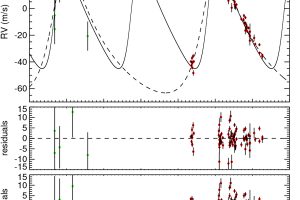Giants planets and stellar metallicity. The study “The GAPS Programme with HARPS-N at TNG XVIII. Two new giant planets around the metal-poor stars HD 220197 and HD 233832” of D. Barbato (UNITO/INAF-OATO) published by A&A

One of the products of the star formation process are disks of gas and dust that orbit young stars during their early evolution, being dispersed by several mechanisms in less than 10 million years. These disks are called “protoplanetary disks”, since they are the structures that may evolve in planetary systems. Planet formation is a complex process that involve several physical and chemical phenomena. During this process, microscopic dusty grains coagulated into larger aggregates, leading to the formation, in just a few million years, of planetesimals, which are planets embryos. How planets such as Jupiter and Saturn accrete their large mass in only a few million years?
Two scenarios have been proposed to explain the formation of giant planets. Following the “Core Accretion Model”, the gas accretes on large solid cores (several times larger than Earth) attracted by their gravity, while the protoplanetary disk still contains large amount of gas. An alternative scenario involves gravitational instabilities, that form over-dense spiral structures in disks which may allow a rapid accretion of large amount of gas onto forming planets.
Is it possible to distinguish which is the dominant scenario? A possible way to this aim is to study the fraction of low-metallicity stars (i.e., stars with a low content of heavy elements compared to hydrogen) hosting giant planets. The efficiency of the “Core Accretion Model”, in fact, is expected to increase with the metallicity of the disk (supposed to have the same of the star), while the efficiency of the gravitational instabilities does not depend on metallicity.
In order to distinguish between these two possible scenarios, the international team led by D. Barbato (Physics Department of the University of Turin and INAF – Astrophysical Observatory of Turin) has analyzed the spectra of 49 low-metallicity stars acquired with HARPS-N, mounted on the Telescopio Nazionale Galileo. As described in “The GAPS Programme with HARPS-N at TNG XVIII. Two new giant planets around the metal-poor stars HD 220197 and HD 233832“, recently appeared on Astronomy & Astrophysics and part of the GAPS (Global Architecture of Planetary Systems) program, two new exoplanets have been identified in two stars of this sample: HD 220197 and HD 233832. The planets orbiting the former star has a mass upper limit of 0.2 Jupiter masses and an orbital period of 1728 days. For the latter planet two possible solutions exist: a mass upper limit of 1.78 Jupiter masses and a orbital period of 2058 days, or 2.72 Jupiter masses and a period of 4047 days. Considering these two planets together with those found in an other sample of 88 low-metallicity stars, the team has found evidence that the fraction of giants planets is an increasing function of stellar metallicity. This thus supports the “Core Accretion Model” as principal mechanism for the formation of giant planets.
The figure (link) shows the orbital fit of the planet orbiting HD 233832.
by Mario Giuseppe Guarcello ( follow mguarce)
